10. Polywell Poly 890FX
 Because of its high price at this cost, a little more TLC from Polywell toward the system’s design could have done wonders.
Because of its high price at this cost, a little more TLC from Polywell toward the system’s design could have done wonders.Poly well includes two USB 3.0 ports grace the system’s rear alongside four USB 2.0 ports, S/PDIF coaxial and optical outputs, two gigabit ethernet ports, integrated 7.1 surround sound, a mini-DisplayPort connector, and a mini-FireWire 400 connector.
Its general performance is nearly identical to that of the category leader, and its gaming capabilities provide enough get-up-and-go to ensure that the X5800A3 remains future-proof for a while. A brand-new processor, a sweet combination of plenty memory and storage capacity, and the next-generation connectivity of USB 3.0 ports are just a few of the awesome features that help this machine challenge every other performance PC we’ve tested.
Polywell didn’t take a lot of time to gussy up the interior of this otherwise eye-catching system. The wiring job leaves much to be desired, with cables strewn every which way throughout the top and bottom of the full-tower case. The last thing anyone wants is for a device’s battery to run out midgame. On top of that, both the mouse and the keyboard come with no additional buttons and features beyond their wireless capabilities.
9. HP Pavilion Elite HPE-390t
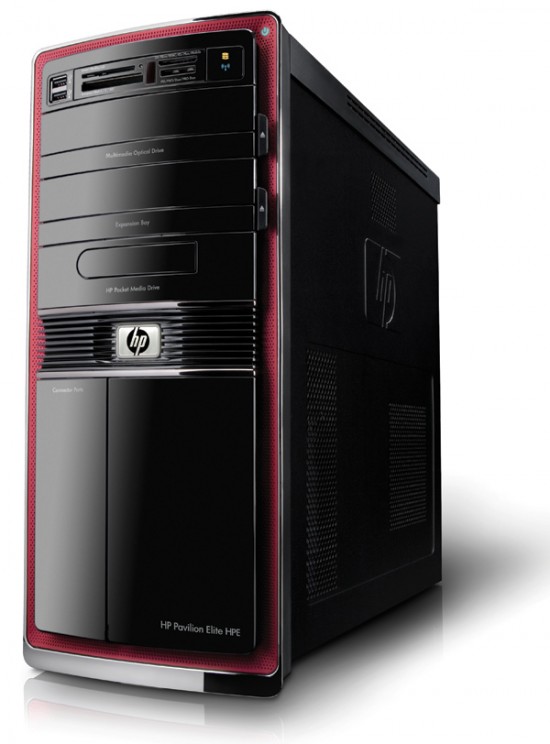 HP’s Pavilion Elite HPE-390t delivers great performance in a humble, media-focused shell. Just be sure to bring your own peripherals.
HP’s Pavilion Elite HPE-390t delivers great performance in a humble, media-focused shell. Just be sure to bring your own peripherals.The stock HP Pavilion framework isn’t nearly as generous. It’s smaller than that of a standard performance machine, which is sure to please buyers intimidated by hulking towers. HP has also outfitted the machine with a full array of media-centric connectors, making the midsize-tower system a suitable living-room PC.
On the front you’ll find a multiformat card reader, plus a pair of USB ports. The PC also has a dock for HP’s Pocket Media Drive. Hidden behind a panel are a third USB port, a FireWire port, composite and S-Video ports, and the microphone and headphone jacks. You also get an infrared input port for the included remote control, and a pair of infrared output ports.
Rounding out the media functionality are composite ports, a coaxial antenna connector, and an S-Video port, courtesy of a TV-tuner card. Media playback, as expected, was flawless in our tests. The HPE-390t’s Radeon 5770 had no problem churning through any of our 1080p material on our test living room’s 46-inch plasma display. More important, though, the machine is fairly quiet: Fans and components were audibly as the system is creeping to life, but once Windows 7 Home Premium (64-bit) is up and running, the PC is all but undectectable.
8. Polywell Poly X5800A3
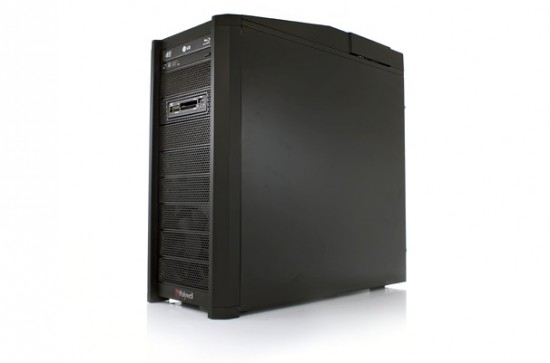 It may not be much to look at, but the Poly X5800A3 offers premier components and delivers fast speeds, making for quite a compelling power PC
It may not be much to look at, but the Poly X5800A3 offers premier components and delivers fast speeds, making for quite a compelling power PCOn our World Bench 6 test suite, the 890FX earned a score of 145, an admirable result for the performance PC category
The front of the case houses four USB ports and a multiformat card reader, as well as the system’s Blu-ray/DVD-burner combination drive. It’s a welcome addition, even though its aesthetics are poorly designed (and it sits smack-dab in the center of the chassis).
The wiring job inside the case is tragic to behold–and then there are the strange metal locking mechanisms used to hold the 890FX’s 5.25-inch devices in place. A single 3.5-inch hard-drive bay joins one free PCI Express x16 slot and one PCI Express slot as the only free, upgradable options you’re going to find in the 890FX. And, as expected, they require screws to secure the various devices.
Polywell includes a wireless keyboard and mouse in the box. The former comes with a few extra buttons for launching applications and controlling multimedia, whereas the latter is merely a generic two-button wireless Logitech mouse. Both are a step up from the standard keyboards and mice we see accompanying most systems, for what it’s worth.
7. MicroExpress MicroFlex 97B
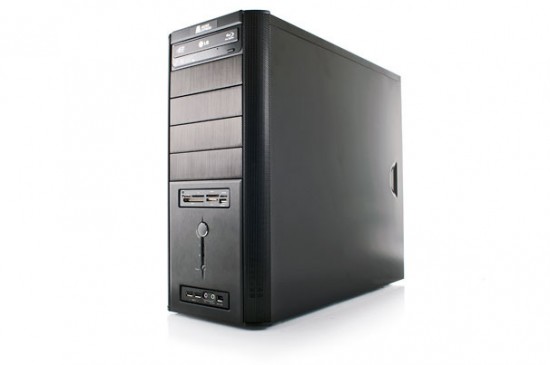 With a few minor exceptions, the 97B provides most of what you’d expect from a reasonably priced high-performance PC. Few can match its combination of power, gaming prowess, and cost.
With a few minor exceptions, the 97B provides most of what you’d expect from a reasonably priced high-performance PC. Few can match its combination of power, gaming prowess, and cost.As we often see on pricier systems, the 97B comes completely equipped to handle any external device you want to link to it. The desktop’s front is a touch anemic, however, with a mere trio of USB ports and a multiformat card reader. While it’s neither the fastest nor the best-designed PC on our performance-PC charts, Its price-to-performance ratio on general tasks and gaming is equally impressive, and the system comes with all the connections to make for a rich, next-generation desktop.
The 97B comes with two free PCI Express x1 slots, two PCI Express x16 slots, and a single PCI slot. We weren’t thrilled with the roughshod wiring job, but its forgivable .It’s a shame, too, that Micro Express doesn’t make better use of this monstrosity by overclocking the CPU a bit.
6. Cyber Power Black Pearl
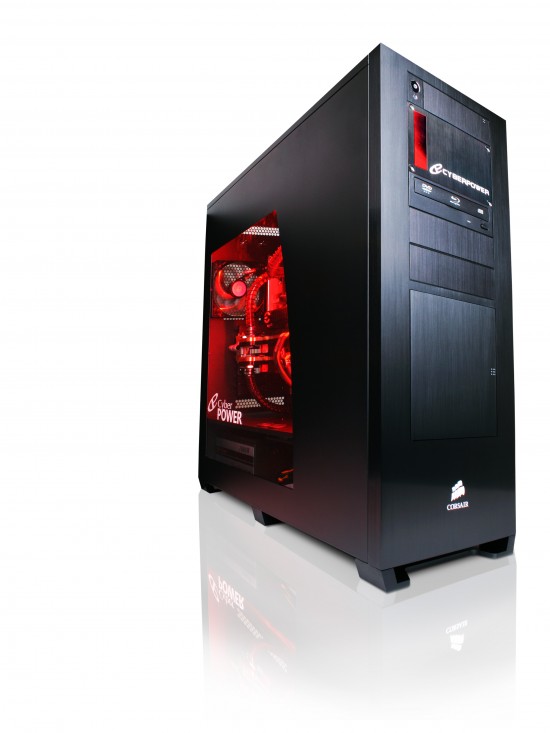 This PC Equipped with Intel’s six-core Core i7-980X processor. It provides best performance as a power user.
This PC Equipped with Intel’s six-core Core i7-980X processor. It provides best performance as a power user.The Black Pearl we reviewed is built around Intel’s Core i7-980X processor, and packs components befitting its high price–such as 6GB of DDR3-1600 RAM.A 2TB hard drive handles storage, while a pair of 64GB solid-state drives arrayed in RAID 0 position host the 64-bit Windows 7 Home Premium operating system.
The Black Pearl’s performance during our lab tests came tantalizingly close to the best we’ve recorded in the category. It earned a score of 171 on WorldBench 6, just behind the 175 earned by the six-corePolywell Poly X5800A3. Maingear’s quad-core Shift remains the performance king, with a WorldBench 6 mark of 181, but it’s also the most expensive of the three by almost $2000.
Oddly, this otherwise well-equipped machine lacks a multiformat card reader–an increasingly popular addition to desktops in all price ranges. The model we reviewed also lacked a mouse and keyboard, and the only documentation was a user guide for the Corsair 800D case.
5. AVADirect Custom Gaming PC
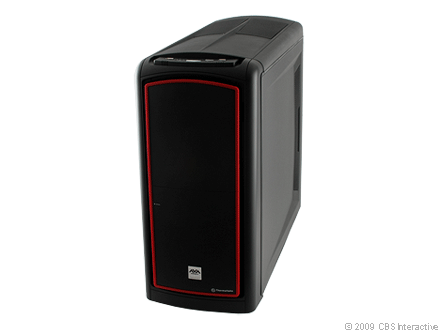 A noisy chassis and rigid competition makes things tricky for AVADirect’s versatile Performance PC.
A noisy chassis and rigid competition makes things tricky for AVADirect’s versatile Performance PC.There are a decent variety of ports available on the top of the machine: a pair of USB 3 connectors, four USB connectors, a FireWire port, serial PS/2 ports for a keyboard and mouse, dual gigabit Ethernet ports, SPDIF, 7.1 and optical audio output ports. The graphics cards offer a total of six DVI ports, and three mini-HDMI ports. You’ll also find a set of manual fan controls — more on that in a moment.
The front of the machine offers two more USB ports and the requisite headphone and microphone jacks. But the most noticeable feature is the nifty NZXT fan controller’s LCD display. With the display, and the manual controls on top, internal temperatures can be monitored at a glance, and tinkerers are afforded rough adjustments to their machine’s fan speeds.
AVADirect’s Custom Gaming PC might not have the most inspiring name, but this blue beast pays homage to the old school of Performance PCs: powerful, imposing, and woefully loud.
4. Digital Storm Black Ops Assassin
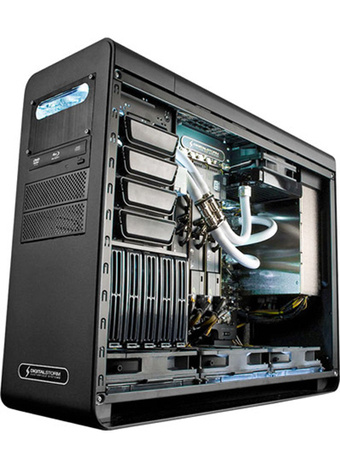 If price is no object, you’ll be hard-pressed to find a better power PC than the beautifully constructed Black Ops Assassin from Digital Storm.
If price is no object, you’ll be hard-pressed to find a better power PC than the beautifully constructed Black Ops Assassin from Digital Storm.Digital Storm’s excellent use of a Silverstone FT02 framework means that a majority of the system’s guts are flipped on their side: All the components connect at the top of the chassis instead of at the rear. The case thus leaves plenty of room for three 180mm fans that thoroughly ventilate the rig from bottom to top, coupled with a soundproofed side window to shield your ears (and mental state) from the din.
The case’s three free hard-drive bays feature handy trays for sliding drives in and out, and the Assassin’s two free 5.25-inch bays (of four available) employ huge, individual buttons to help you stick your devices in place.
Even considering the borderline-absurd air cooling in the Assassin, it’s interesting that Digital Storm didn’t opt to slap a water-cooling setup over the system’s Intel Core i7-930 processor. The CPU is over clocked from its stock frequency of 2.8GHz, up to 3.8GHz. That tweak–together with the system’s 6GB of DDR3 memory and 128GB SSD boot drive–helped the Assassin shoot close to the top of the rankings on our World Bench 6 general-performance tests, with a score of 172. That’s a mere 9 points behind the mark of the $7000 Maingear Shift, but a significant cost-for-performance victory.
3. Origin Genesis Midtower Desktop
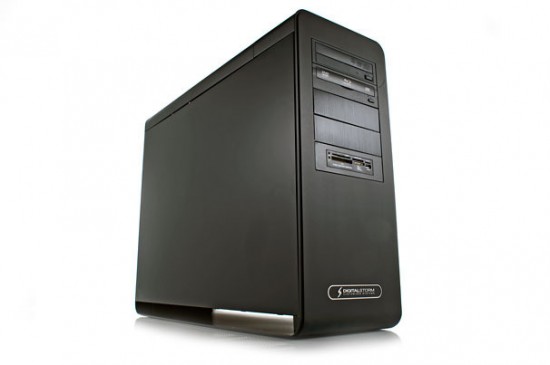 Packed with liquid-cooled, over clocked components, the midtower variant of Origin’s Genesis is every bit as potent (and pricey) as its larger sibling.
Packed with liquid-cooled, over clocked components, the midtower variant of Origin’s Genesis is every bit as potent (and pricey) as its larger sibling.The machine also offers 12GB of DDR3-1600MHz RAM and 1.6TB of hard-drive space (a pair of solid-state drives in RAID 0 for booting, and a 1.5TB hard drive for storage).The Genesis midtower’s ability comes courtesy of an overclocked, liquid-cooled Intel CPU, a 2.8GHz Core i7-930 processor pushed to 4.0GHz.
Keep in mind, however, that such numbers are exemplary–anything over 30 frames per second is generally considered playable, and once you’ve eclipse 60 frames per second, you really don’t have much room to complain. An extremely high graphics score can help you measure a machine’s durability these PCs aren’t likely to fall behind the curve in the near future. This is especially critical in the performance PC category,.
It isn’t especially attractive, but it is an expansive, strong case–and, more important, it offers tool-free access to all of the machine’s guts. A thumbscrew keeps the side door in place. Once you remove it, you’ll be able to swap out optical drives, hard drives, and PCI cards by using a selection of levers and switches.
The system has four hard-drive bays; the pair of SSDs shares one bay, leaving two bays for future expansion. You’ll also find a total of five bays available for adding 5.25-inch drives, but the graphics card blocks one.
2. Maingear Shift Gaming Desktop PC
 Maingear’s Shift is a flashier system, but that doesn’t mean this beautiful monster is perfectly priced for its performance.
Maingear’s Shift is a flashier system, but that doesn’t mean this beautiful monster is perfectly priced for its performance.Maingear Shift power PC to give you a backrub and wash your car while it goes about its day of high-performance computing. This system’s includes graphics—three single-GPU XFX Radeon HD 5870 graphics cards delivering eye-popping CrossFire performance that’s currently unmatched by any system. The Shift’s specs are extremely impressive on paper. The included 3.33GHz Intel Core i7 975 Extreme Edition processor is the fastest money.
Coupled with six gigabytes of DDR3-2000 memory and two Intel X25-M 80GB solid-state drives.
The 204 frames per second it spits out on PC That’s plenty of headroom for an extra dual-GPU GTX 295 video card and, if you’re feeling cunning, a switch from the system’s included 640GB primary drives to SSDs (or a RAID setup of multiple terabyte drives). You could afford all these tweaks and still beat the Maingear Shift’s price. You might not top its performance, but you’ll come pretty sew close with a sack of money to spare.
1. Origin Genesis
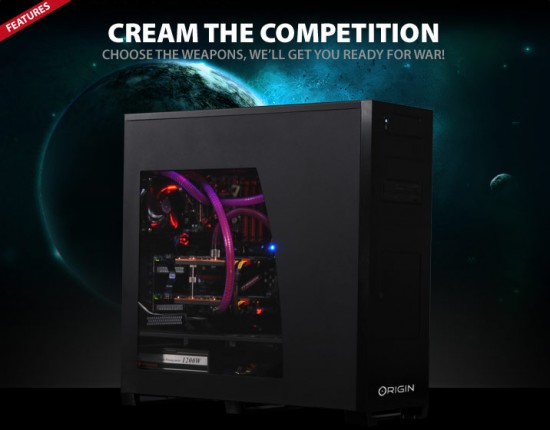 Offering the highest general performance we’ve seen to date, the Genesis is debatably worth the arm and leg that Origin is asking in trade.
Offering the highest general performance we’ve seen to date, the Genesis is debatably worth the arm and leg that Origin is asking in trade.Origin is a newcomer to the boutique PC seller field. Though the company is relatively young, it’s manned by former Alien ware bigwigs who thoroughly understand high-end PCs. Origin spared no expense in assembling the Genesis’s load out. At the machine’s heart is a Core i7-980X, Intel’s six-core, performance-oriented processor. The CPU is overclocked from its stock speed of 3.33GHz up to 4.3GHz; a network of blood-red major tubing pumps liquid coolant around the framework, lest the silicon fry. It also offers 12GB of DDR3-1600MHz RAM and 2.1TB of space, in pair form of solid-state drives in RAID 0, and a pair of 1TB storage drives.



0 Komentar:
Posting Komentar